
Established April 14, 1942
 |
American Ex-Prisoners of War
A not-for-profit, Congressionally-chartered veterans’ service organization advocating for former prisoners of war and their families.
Established April 14, 1942 |


Edward Slayman and his wife Marian Anna Slayman
|
||
| Last Name | First Name, Middle Init. | Nickname |
| Street Add. | City | State |
| Zip | Spouse | |
| Conflict | Branch of Service | Unit: |
| Theatre of Operation | Military Job | Where Captured |
| Date Captured | Time Interned | Camps |
| Date Liberated | Medals Received | Age at Capture |
| After the War ... | ||
In February 1944 Ed Entered the Army and was assigned to basic training at Camp Croft, SC and to Europe by way of Camp Miles Standish, Boston, MA. Sailed on the Mariposa via Liverpool, Southampton, Omaha Beach and LaMans. From there to Nancy to join the Santa Fe Division (35th Div., 137th Inf, Co. K.) Arrived there about September 7, 1944.
"At first we were assigned to clear out areas of bypassed pockets of Germans, then sent to Frense, France to serve as an outpost with the 320th Armored Inf. They pulled out the night we arrived, The following day we were attacked by a large group of Jerrys. We were able to turn them back, but in doing so we expended all our ammo. Two men were sent back for more that night. They did not return: they were captured on the way back.
"The next day they sent armor after us. We retreated back to town, but found we could go no further because the Jerrys were behind us too. Holing up in a barn on the edge of town, we thought that our boys would put a push on, then we would be home again. It didn't happen that way. We were in that barn for ten days before our P51s and P47s strafed and bombed the place -- setting our home away from home on fire.
"We were able to go about a half mile before being surrounded and captured. They marched us several miles that night to a schoolhouse for interrogation. Then they marched us on to Stalag 12A over a period of several days. While there I developed pleurisy and my feet became infected.
"On 12/16/44 they moved most of us to the railroad yards to send us to Stalag 4B (They were making room for the Battle of the Bulge boys.). They issued us a loaf of bread and a 2 1/2 size can of corned beef between seven men and crammed us into a box car with only room for about half of the boys to sit. The box car doors never opened. We arrived at 4B on 12/24/44, with about 24 inches of snow on the ground.
"Due to my weakened condition, I was unable to walk and was placed in the lazaret. The food was fair and I was able to walk by New Year's Day, and then sent back to my group.
"I had heard that on a work commando you were fed better, so I volunteered. On January 16, 1945, I went with a group of 25 other to Brand Erbisdorf (between Chemnitz and Dresden) to work at a place where wood was chopped up to burn in automobiles. (They run on the gasses produced.) We worked there until April 1, 1945, when the U.S. Army took Chemnitz. They moved us out to Dresden on a train, from there we journeyed on foot toward Prague. We were given a wagon with food in it; we supplied to horsepower to move it.
"My buddy, Ira Clark of Niles, MI, and I planned an escape. I was able to get a loaf of bread and a can of meat while pushing the wagon.
"We made good on our escape. Though we had decided to travel by night, it proved to be difficult because of cloud cover, and not being able to see the moon and stars. After traveling in circles for several days, we stared to travel in daylight. It was our undoing. We were captured by local police and civilians. On April 28, 1945 they returned us to our group, about thirty miles away. We were housed in barns until May 8, 1945, when the rumor got out the war was over.
"After making our way to Teplice, Czeck, we were in the wrong place at the wrong time again. The SS troops in that area wouldn't give up. With the road out of Teplice jammed full of civilians. soldiers, and vehicles, we were strafed by Russian planes. My Buddy, Clark, was very badly wounded. Three others were killed.
"I was able to get a German Medic to fix up Clark. With the help of a solider from South Africa we commandeered an ambulance and took off toward Komatou. On the way we met a Russian convoy. They put us on a truck, shot the German medics, and took the ambulance with Clark and an English solider inside it. I later found out that they had put the ambulance in a motor pool, leaving my buddies inside. Some children found them, told their parents, and the Red Cross was contacted. (Clark and I still see one another.)
"I made it to Karlsbad. From there we were taken to Eger, Regensburng, Rheims, CampLucky, Strike, and LeHarve. On June 10, 1945 we boarded the Liberty ship SS John S. Pillsbury bound for New York and Camp Shanks. Arriving there on June 21, 1945, I went on to Fort Meade and a 77-day furlough, followed by two weeks at the Royal Palm Hotel, Miami Beach, before Proceeding on to Camp Stoneman, CA.
"When Congress mandated all POWs be discharged at once, I was sent to Camp Beale, CA. and discharged on November 25, 1945. The discharge officer was Maj. Paul (Daffy) Dean. Who could ask for anything more on Thanksgiving Day?"